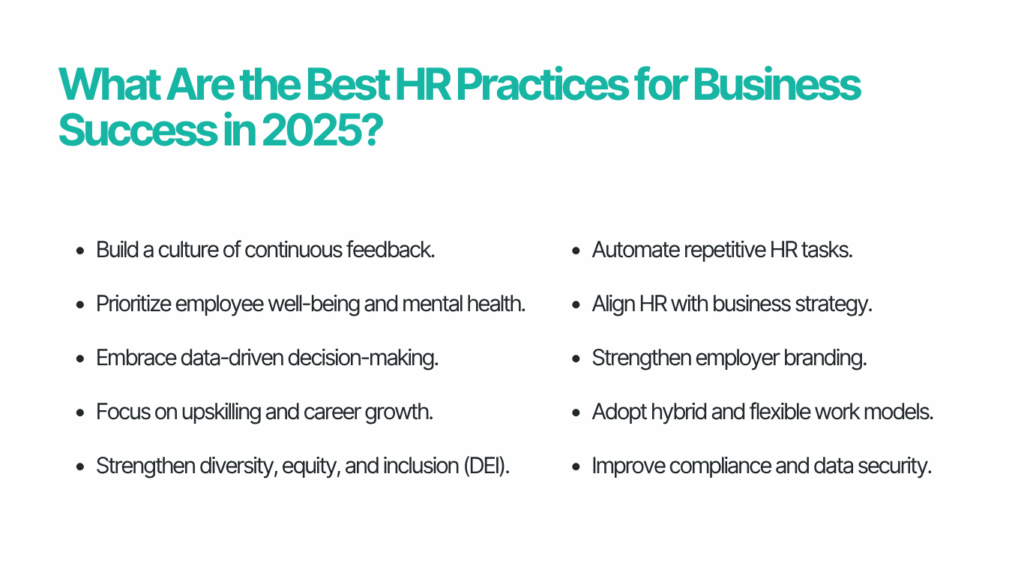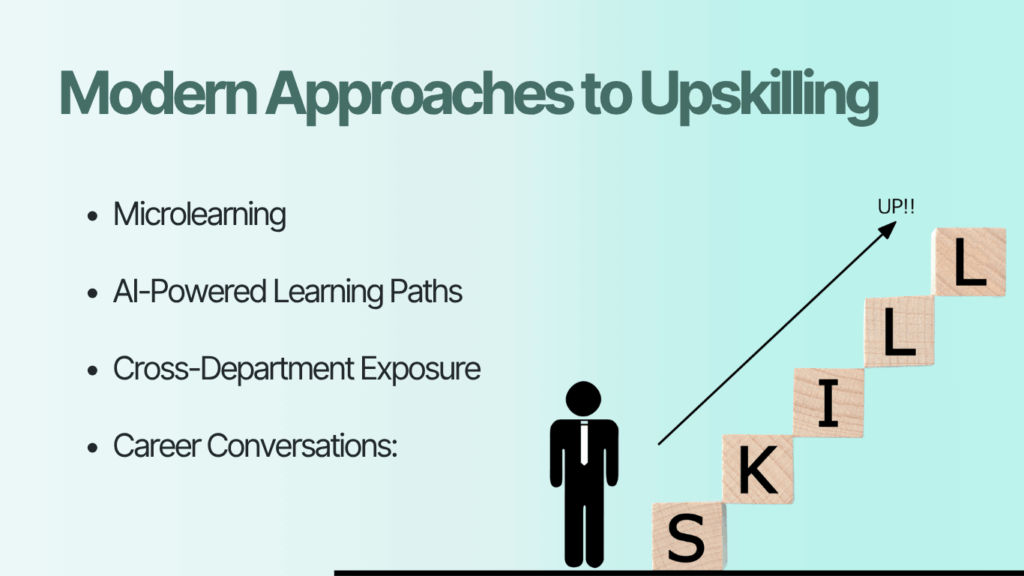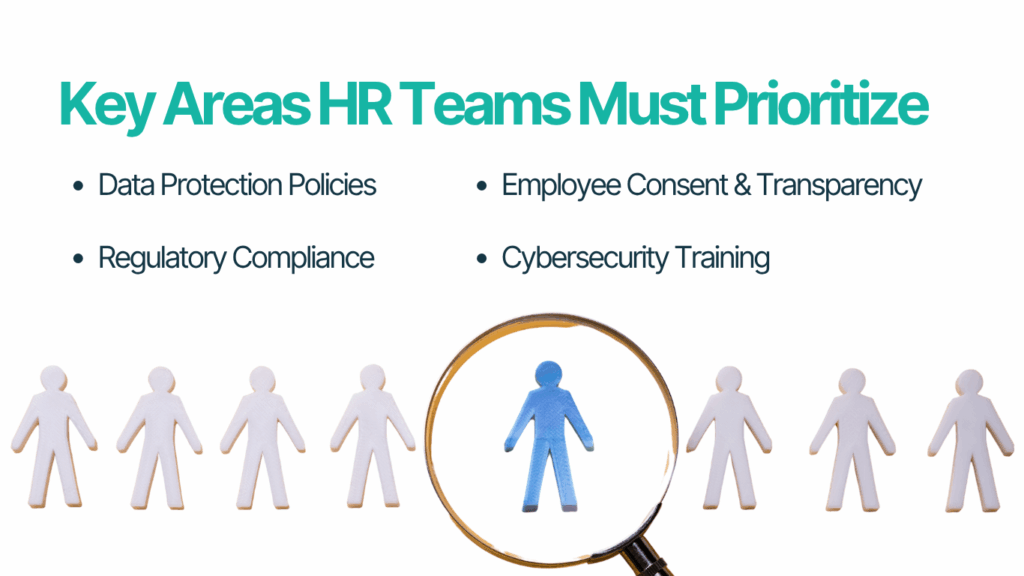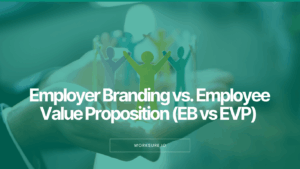As workplaces become hybrid, technology gets smarter, and employee expectations rise, HR’s role is no longer limited to hiring and payroll. It now shapes company culture, performance, and long-term success.
A 2024 Gartner survey found that 82% of organizations believe adapting HR practices to new technologies and workforce trends is key to staying competitive. In 2025, this means adopting smarter, data-driven, and people-first approaches to talent management.
This blog explores 10 HR best practices for business success in 2025, from continuous feedback and employee well-being to automation and compliance. Each practice can help you create a more agile, engaged, and future-ready workforce.
What Are the Best HR Practices for Business Success in 2025?
The best HR practices for business success in 2025 balance technology, employee experience, and organizational goals. Companies that invest in modern HR practices are seeing higher retention, stronger engagement, and better financial outcomes.
Below are the 10 HR best practices shaping successful organizations this year:
- Build a culture of continuous feedback.
- Prioritize employee well-being and mental health.
- Embrace data-driven decision-making.
- Focus on upskilling and career growth.
- Strengthen diversity, equity, and inclusion (DEI).
- Automate repetitive HR tasks.
- Align HR with business strategy.
- Strengthen employer branding.
- Adopt hybrid and flexible work models.
- Improve compliance and data security.

Each of these practices plays a vital role in building a workplace that attracts top talent, and retains valuable employees.
1. Build a Culture of Continuous Feedback
In 2026, top-performing companies are moving toward continuous feedback systems that help employees grow throughout the year. This shift promotes transparency, faster learning, and stronger engagement.
A Gallup study found that employees who receive regular feedback are 3.6 times more likely to be motivated to perform their best. Continuous feedback also helps managers spot issues early and align goals with real-time performance.
To build a feedback culture:
- Replace annual reviews with monthly or quarterly check-ins.
- Use digital tools to document progress and feedback notes.
- Train managers to give constructive, specific, and timely input.
- Recognize achievements publicly to reinforce positive behavior.
2. Prioritize Employee Well-Being and Mental Health
Healthy, supported employees bring more focus, creativity, and loyalty to work. When organizations ignore mental health, performance drops, absenteeism rises, and turnover costs multiply.
According to the World Health Organization (WHO), depression and anxiety cost the global economy over $1 trillion each year in lost productivity. Companies that invest in mental health programs, flexible schedules, and open communication are building stronger teams.
Let’s look at what modern well-being strategies include today:
| Focus Area | What It Means | Example Action |
| Flexible Work | Respecting work-life balance | Allow hybrid hours or remote options |
| Mental Health Support | Access to therapy or wellness platforms | Offer subsidized counseling or apps like Calm |
| Manager Training | Teaching empathy & burnout detection | Conduct quarterly workshops |
| Recognition Programs | Acknowledging effort & resilience | “Employee of the Month” or appreciation shout-outs |
Employees now expect psychological safety as much as financial security. A survey by McKinsey & Company revealed that 60% of workers would leave a job if their employer didn’t care about mental well-being.
3. Embrace Data-Driven Decision Making
Data-driven HR helps teams spot hiring trends, predict turnover, measure engagement, and improve workforce planning with precision. Instead of relying on intuition, HR leaders now use dashboards and analytics to answer questions like:

A report by Deloitte Insights found that 71% of organizations using HR analytics have seen measurable improvements in decision-making and employee outcomes.
Why It Matters
- Better Hiring Decisions: Data helps you identify which candidate sources bring top performers.
- Improved Retention: Analytics reveal early warning signs of disengagement.
- Optimized Training: Learning data shows what skills deliver ROI.
4. Focus on Upskilling and Career Growth
The most successful organizations understand that investing in learning and development (L&D) is one of the strongest retention tools available.
According to LinkedIn’s 2024 Workplace Learning Report, 94% of employees say they would stay longer at a company that invests in their career development. Upskilling fills internal skill gaps that are costly to replace through external hiring.
Modern Approaches to Upskilling
- Microlearning: Short, focused lessons on-demand — ideal for busy teams.
- AI-Powered Learning Paths: Personalized training recommendations based on role or performance.
- Cross-Department Exposure: Encouraging collaboration between teams to build new capabilities.
- Career Conversations: Regular discussions about goals, skill growth, and promotion readiness.

A healthcare organization adopted a quarterly “Learning Friday” program where employees dedicate two hours to skill-building. Within eight months, engagement scores rose by 18%, and internal promotions increased by 12%.
When employees see a clear growth path, they’re more likely to stay engaged, motivated, and loyal to your organization.
5. Strengthen Diversity, Equity, and Inclusion (DEI)
Diversity is about building a workplace where everyone feels valued, respected, and heard. Research from McKinsey & Company shows that companies in the top quartile for diversity are 36% more likely to outperform their peers in profitability. Let’s look at how modern organizations approach DEI today:

1. Redefine Recruitment
- Use blind screening to minimize bias in hiring
- Write inclusive job descriptions that attract a broader range of candidates.
2. Make Inclusion Measurable
- Track representation data across departments and leadership roles.
- Conduct regular surveys to gauge inclusion and belonging.
3. Build Everyday Equity
- Ensure fair pay and equal opportunities for advancement.
- Create safe channels for employees to voice concerns anonymously.
4. Educate and Empower
- Host workshops on unconscious bias and cultural intelligence.
- Encourage team discussions that celebrate diversity rather than just “check a box.”
Here’s a quick snapshot of key DEI goals organizations are focusing on in 2025:
| Goal | Example Metric | Why It Matters |
| Gender parity in leadership | 50% female representation | Drives balanced decision-making |
| Inclusive hiring pipeline | 30% diverse candidates per role | Broadens talent reach |
| Regular bias training | Quarterly sessions | Builds awareness and empathy |
WorkSure helps HR teams promote fair, transparent hiring and employee management, giving every candidate and team member equal opportunity to thrive.
6. Automate Repetitive HR Tasks
Think of how much time your HR team spends on manual work — collecting employee documents, sending reminders, tracking attendance, or managing verifications. Now imagine if those hours could be spent building strategies, improving culture, or analyzing data instead. That’s the power of automation in HR.
Where Automation Creates the Biggest Impact
- Recruitment: Automated screening and onboarding reduce hiring time by up to 50%.
- Payroll & Attendance: Integrated systems eliminate manual errors and delays.
- Employee Records: Digital document management ensures compliance and easy access.
- Verification & Compliance: Tools like WorkSure make employment checks instant and accurate.

Automation Stats to Note
- 74% of HR leaders say automation improves accuracy and reduces workload (PwC, 2024).
- 67% of companies use AI-powered HR software for at least one daily process (SHRM).
WorkSure automates verification and employee record management, saving HR teams hours of manual work each week and keeping compliance effortless.
7. Align HR with Business Strategy
In 2025, the most successful organizations are the ones where HR leaders sit at the same table as CEOs, shaping the direction of the company through data, talent, and culture.
When HR aligns its goals with overall business objectives, every hiring decision, training program, and policy starts contributing directly to growth.
Here’s How Strategic Alignment Works in Practice:

Understand the Business Vision
HR leaders must know where the company is headed — expansion, innovation, or retention — and align workforce planning accordingly.
Turn Data into Direction
Recruitment data, performance metrics, and turnover trends reveal where the organization is strong or struggling. HR can use this data to guide hiring and leadership decisions.
Design for Agility
Instead of static structures, HR should support flexible teams that can adapt to change quickly, especially in fast-moving industries like tech and healthcare.
Measure What Matters
Tie HR metrics (like engagement, retention, and productivity) to revenue or client outcomes. This proves the real ROI of people initiatives.
A Harvard Business Review study found that companies with strong HR-business alignment are 58% more likely to exceed their performance goals.
8. Strengthen Employer Branding
People no longer join companies just for pay — they join for purpose, culture, and credibility. That’s why employer branding has become one of the most powerful tools in HR’s arsenal.
Think of employer branding as your public promise to employees, the image you project through your website, social media, job listings, and even how your team speaks about your organization online.
A report from Glassdoor revealed that 86% of job seekers check reviews and company culture before deciding to apply.
How to Strengthen Your Employer Brand
- Highlight Real Stories: Share employee journeys, testimonials, and milestones on social platforms.
- Show Transparency: Publish your company’s mission, values, and social impact clearly.
- Encourage Advocacy: Empower employees to share authentic workplace experiences online.
- Respond to Feedback: Whether it’s Glassdoor reviews or LinkedIn comments — acknowledgment builds trust.
9. Adopt Hybrid and Flexible Work Models
According to Microsoft’s Work Trend Index, over 70% of employees now expect flexible work options as a standard benefit, not a privilege. Businesses that resist flexibility risk losing top talent to more adaptable competitors.
Unlike the rushed remote setups of 2020, today’s hybrid systems are strategic. Companies use smart scheduling, collaboration tools, and clear communication norms to maintain productivity and connection across locations.
Here’s what modern flexibility looks like in action:
| Model Type | Description | Best For |
| Hybrid-Office | Mix of in-office and remote days | Large teams or creative collaboration |
| Fully Remote | Work from anywhere | Tech and knowledge-based roles |
| Flexible Hours | Employees choose their working times | Roles requiring focus and autonomy |
Benefits for Both Sides
- For Employees: Better work-life balance and reduced burnout.
- For Employers: Lower overhead, access to wider talent pools, and higher productivity.
But flexibility only succeeds when paired with accountability. Clear goals, outcome-based evaluations, and transparent communication ensure performance stays strong regardless of where people work.
A Stanford University study found that hybrid employees were 13% more productive and reported greater job satisfaction than those in traditional setups.
10. Improve Compliance and Data Security
A PwC survey revealed that 85% of organizations view HR data as highly sensitive, yet over 40% still rely on outdated storage systems. This gap exposes businesses to compliance risks, especially when handling payroll, identity, and health information.
Key Areas HR Teams Must Prioritize

1. Data Protection Policies
Use secure platforms for storing and sharing employee documents. Regularly update access permissions to prevent data leaks.
2. Regulatory Compliance
Stay updated with local and global labor laws, from GDPR to evolving data privacy frameworks in Asia and the Middle East.
3. Employee Consent & Transparency
Always inform employees about how their data is used. Transparent communication builds confidence and protects the company from legal issues.
4. Cybersecurity Training
Conduct workshops for HR and employees to recognize phishing, identity theft, and other cyber threats.
Final Thoughts
Each of the ten best practices we explored — from feedback culture and employee well-being to automation, DEI, and data security, points to one powerful truth: sustainable business success starts with people-first strategies.
In an age of constant change, employees expect personalization, transparency, and flexibility. At the same time, leaders need smarter tools to make faster, more informed decisions. This is where a modern, integrated HR approach makes all the difference.
By adopting these practices, your organization can:
- Attract and retain top talent with a strong employer brand.
- Build an agile, learning-focused culture.
- Strengthen compliance and security without slowing down processes.
- Connect HR goals directly to business growth.
WorkSure helps HR teams do just that — by automating verification, streamlining compliance, and empowering leaders to focus on what truly matters. Schedule a meeting now to understand how it supports your HR team.
Related Articles:
Best Practices for a Transparent Recruitment Process
Top 10 HR Tech Trends to Watch in 2025
FAQs — HR Best Practices for Business Success in 2025
1. What are HR best practices for business success in 2025?
HR best practices in 2025 focus on creating data-driven, people-first workplaces. They include continuous feedback, employee well-being, automation, DEI, and aligning HR with business strategy. Together, these practices help organizations attract top talent, boost engagement, and achieve long-term success.
2. Why is continuous feedback important in HR?
Continuous feedback helps employees grow faster by replacing once-a-year reviews with ongoing conversations. It builds trust, encourages improvement in real time, and strengthens team communication — all of which drive better performance and retention.
3. How does HR automation benefit a business?
HR automation saves time by handling repetitive tasks like onboarding, attendance, and verification. It reduces manual errors, ensures compliance, and allows HR teams to focus on strategy, culture, and employee engagement — areas that directly impact business growth.
4. How can HR improve employee well-being?
HR can improve well-being through flexible work policies, mental health support, recognition programs, and regular check-ins. When employees feel cared for, their productivity, creativity, and loyalty to the organization increase.
5. Why is DEI important for business success?
Diversity, Equity, and Inclusion (DEI) lead to stronger innovation and decision-making. Teams that include diverse perspectives are more adaptable and outperform less diverse peers, helping businesses grow sustainably and maintain a positive brand reputation.





